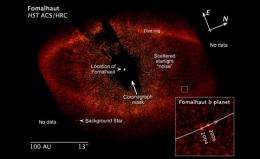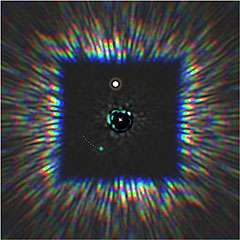Planet Imager will enable telescopes to image extrasolar planets directly

The best way to observe objects in solar systems is simply to look -- but distortions caused by Earth's atmosphere drown out much of the spectacle of space. To address this problem, Berkeley astronomer James Graham and colleagues are designing an adaptive optics system that can spot new planets.
For as long as we have viewed the moon and stars, humans have wondered about the existence of other worlds. Though planets in our own solar system such as Venus, Mars, Jupiter and Saturn have been known since antiquity, those circling other suns have proved far more difficult to find. In fact, the first definitive detection of an extrasolar planet orbiting a star like our Sun didn't occur until 1995.
Since then, astronomers have hunted planets primarily by observing the gravitational wobbles big planets impose on their suns. Though this method has found more than 300 extrasolar worlds to date, it tends to miss those that are small or reside far from their stars.
Now astronomers like James Graham are getting more ambitious. "We want to know the full range of objects that orbit in solar systems," says the Berkeley professor of astronomy. "And the easiest way to explore these outer regions is just to look."
Photos, Graham says, provide information about planets that can't be obtained any other way. "If you can collect light from the planet, then you can start to study what it's made of, how hot it is, even how it was made. You can start doing comparative planetology," Graham says.
Actual planet spotting, however, is tricky. Stars can be several billion times brighter than their orbiting planets. "It's much worse than seeing a firefly next to a searchlight," Graham says.

A case in point is the star Formalhaut. Surrounded by a diaphanous disk of dust kicked up by collisions between rocky objects, Formalhaut has long been considered a prime spot for planet hunting.
Graham and fellow Berkeley astronomer Paul Kalas, analyzed a 2004 photo of the star taken by the Hubble Space Telescope and found a distinct gap between the dust and the Formalhaut itself. Their observations demonstrated that something very big was booting the dust and asteroids out of the way.
This orbiting housekeeper indeed turned out to be a planet. In November of 2008, Berkeley astronomer Eugene Chiang joined Graham and Kalas to announce the first-ever image of a planet outside our solar system. A tiny dot on an image filled with light, Formalhaut b is located so far from its star that it requires 872 years to complete one orbit. A device on the Hubble Space Telescope called a coronagraph, which blocks out much of Formalhaut's glare, helps make the planet visible.
Exciting as it is, that photo also illustrates the limitations of existing telescopes. Streaks radiate from the center of the photo, the result of distortion from imperfect telescope optics. Like scratches on a windshield, these streaks make it difficult to identify additional planets within the noise.
Earth's turbulent atmosphere makes distortion even more extreme for ground-based telescopes. To illustrate, Graham switches on the lava lamp on his desk. Pink-tinged blobs of waxy paraffin expand as they are heated from below, rise, then fall as they cool. "It's what happens when sunlight heats Earth's surface and the air above it rises," Graham says.
The column of air above a telescope might contain dozens of pockets of warm air within a colder backdrop. Because they are less dense, these warm pockets convey light faster than the colder air around them. Any starlight filtering through these pockets gets distorted. Instead of focusing on one point in the telescope, the light smears into what Graham calls a "splodge." "The size of the splodge is so large that you couldn't find any planets within the star's solar neighborhood—you couldn't look that close to the star," he says.
To solve this problem, Graham and colleague Bruce Macintosh at Lawrence Livermore National Lab have been designing an adaptive optics system for the 8-meter telescopes of the international Gemini Observatory, which has facilities in Hawaii and the Chilean Andes. Called the Gemini Planet Imager, it will enable astronomers' telescopes to image extrasolar planets directly.
The system consists of thin secondary mirrors placed behind the telescope's existing optics. Tiny actuators bend these mirrors to cancel out atmospheric errors. Sightings from a distant star are used to measure the type and degree of correction required.
Making it work is a formidable task involving an international team of engineers and scientists. "The errors projected onto the telescope are changing every few milliseconds. You need to make these measurements thousands of times a second to be able to correct for the cumulative errors, compute how to bend the mirror, then deform the mirror rapidly enough to keep up," says Graham, who began work on the project in 2003.
The $18 million system is scheduled to go online in 2011. Let's hope those distant worlds are ready for their close-ups by then.
Source: UC Berkeley, ScienceMatters@Berkeley




















